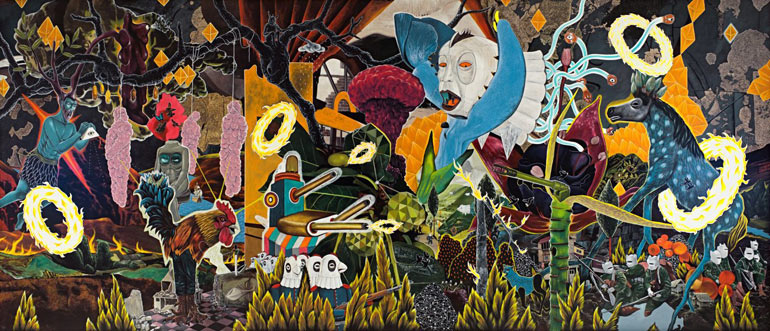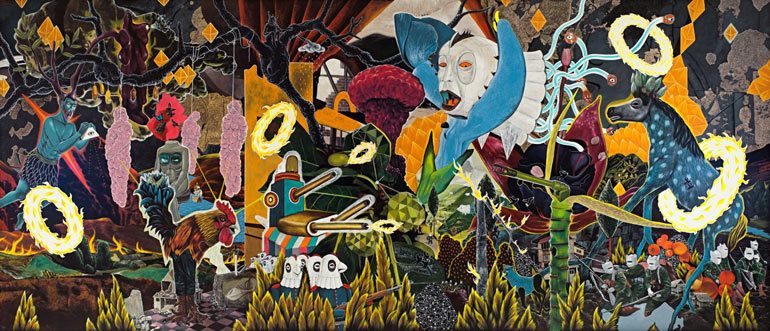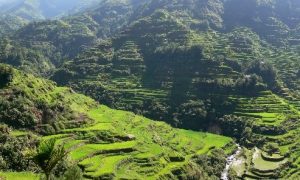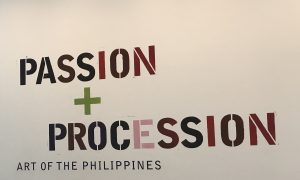While waiting for the others to arrive, we wander into the AGNSW’s gift shop. I somewhat excessively fondle various objects (perhaps making up for the fact that I won’t be able to later): a ridiculous tea-leaf holder, some gag cards, posters of famous paintings I’ve never heard of, and a silk scarf I can’t afford.
As I stroke the scarf I have an irrational urge to turn to my companion, grab their arm and confess with a crazed look in my eyes, that art galleries aren’t often high on my to-go list, does this make me a bad humanities scholar?
But instead I continue browsing. What is all this stuff for sale doing here? I wonder that at the same time I thank my companion for letting me use their member’s discount for a brand new bedside pocket.
[2] (From AGNSW website)
(From AGNSW website)
We spend a lot of time talking about Do you have a rooster, Pedro? (Adda manok mo, Pedro?) by Rodel Tapaya. It is the headlining piece, and for good reason. It is a magnificent and terrifying depiction of conflict and the incredibly complex Mamasapano clash, which for some reason was not named in the work’s curatorial description.
Hunting the Secrets of the Philippines
What makes the Philippines tick, and what's the one piece of art, object or artefact that could provide an answer?
In this description I read “Gift of Geoff Ainsworth AM and Johanna Featherstone”. I Google Geoff Ainsworth and immediately feel a flash of irritation as I see that he is a part of the all-white AGNSW Board of Trustees with the sole exception of contemporary artist Khadim Ali. I bet they drink a lot of champagne, was the unkind thought that came to mind.
(For your information: Former executive director of the Art Gallery Society of NSW, Judith White, wrote a whistleblowing book on the corporatisation of the AGNSW called Culture Heist: Art versus Money. This is AGNSW’s response. The book is not sold in the gallery shop.
As to the lack of diverse cultural representation in the Gallery, indigenous curator Hetti Perkins resigned the institution in 2011 in frustration when the AGNSW ignored her pushes to refurbish its Yiribana Gallery, which has remained the same for 20 years.)
[3]
I am exhausted by the choreography of the Gallery Shuffle: the slow motion of stop, step, stop, shift weight of legs from left to right, repeat along the imaginary conveyor belt that is the route you’re supposed to take. The Gallery Shuffle happens most prominently in exhibitions where there’s little interactivity. For this particular exhibition I’m looking way more than I’m feeling. Perhaps it’s because I am not religious in the least and there is an abundance in Roman Catholic imagery with the exception of the ‘tribal’ Mindanao textiles (one thing some of us pointed out was the dichotomous and somewhat imbalanced depictions of North and South Philippines, hopefully more on this next week).
[4]
Female bodies and depictions are almost nowhere to be found, but incomplete traces of them are everywhere, with mostly religious connotations. There is a disturbing wooden sculpture of a headless woman with a pregnant figure in her belly, shackled to the ground by a skirt-like cage (Renato Habulan). It is not the only sculpture with a headless woman, or a pregnant one.
[5]When we finish I reread the description as written by the curators. It’s got all the right fashionable components and phrases for a Southeast Asian exhibition: “ritual objects”, “folk mythology”, “social inequality”; “reconsider established narratives of history and nation”, “the potential of art to inspire, heal and effect social change”. I don’t like the fact that these words are so vague and devoid of context that they can be summarily applied to any Other country. I don’t like the emptiness of the phrase “effect social change”, stripped of its power after endless repetition in these circles.
I know I use some of these trendy phrases in my work. That is something I have to reckon with.
 Facebook
Facebook  Twitter
Twitter  Soundcloud
Soundcloud  Youtube
Youtube  Rss
Rss 


